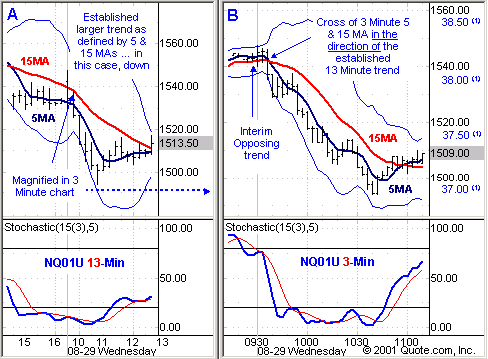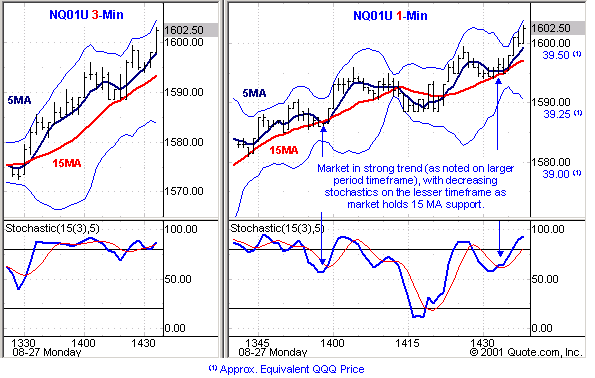Key Intraday Moving Average Setups In The QQQs
It seems that the concept of using moving
averages (MAs) to gauge markets and market trends has been around forever.
They’re simple, easily understood, and can be taught on day one of your local
“Trading 101” course. I suppose for those who like a little spice to
go along with their trading, they can be considered downright boring. Yet I
continue to find MAs among the more important weapons in the trader’s arsenal as
a result of their ability to provide benefits beyond mere trend documentation.
Among the roles MAs can play are support “safety nets,” entry triggers
under certain circumstances, solid stop triggers on initial entries, and
effective trailing stop premises when scaling out of profitable trades.
Before discussing the specifics of how I use MAs in trading the QQQ, I’d like to
stress that any trend indicator is just one piece of the larger market puzzle.
For example, I’m typically interested in three attributes of a market to
evaluate entries or exits on any given time frame: trend, range and momentum
strength. And like three legs of a stool, each characteristic is equally
important and loses its significance if taken alone. Second, there are
indicators other than moving averages that help define a trend, including a
fascinating Japanese candlestick technique of three-line break charts (perhaps a
topic for a future lesson). And lastly, there are multiple ways to structure MAs
including simple vs. exponential, choosing among an infinite number of periods,
and using a single MA vs. multiple MAs depending on one’s personal preference.
So, let’s discuss a few ways of how I use MAs to identify intraday QQQ trading
opportunities. As noted in my columns, I prefer to use dual five- and 15-period
simple MAs to gauge trend direction for multiple time frames, using the
15-period MA as support for the current trend until violated. Crosses of the 15-MA
are considered to be a change in trend direction. With that backdrop, I’d like
to share two of my favorite setups, both of which fall into the category of
trend continuation plays:
1. Opposing Trend
Trigger
This setup involves using two time periods, or what I’ll call the
“traded” time frame and the “trigger” time frame. The traded
time frame consists of a trending market one desires to enter in a low-risk,
high-probability manner on a pullback toward trend support. The trigger period
is a smaller interval that, for the moment, is trading in a direction opposite
that of the traded time frame. In essence, the current trigger trend reflects
the pullback attribute of the larger period.
The trigger period is aptly named because it provides the signal for one to
enter the trade upon an MA cross that aligns the trigger trend with the traded
trend. The following charts illustrate the use of this technique. In this case,
we’re looking to enter on a pullback of an established 13-minute downtrend
(Chart A), using a reversal in the opposing three-minute trend to trigger the
entry:
Traded Period
Trigger Period

(1)
Approx. Equivalent QQQ Price
The beauty of this
entry is twofold. First, the cross of the trigger time frame provides additional
evidence that a continuation of the traded trend has begun to occur, as opposed
to simply fading into an entry without such confirmation. Second, once the
trigger time frame aligns itself with the traded period, its own 15-MA support
can be used to fine-tune exits and trailing stops on the trade.
Now one of the questions I’m asked frequently is how does one define an MA
“cross.” This is not easily answered, as there are multiple
definitions of a cross, including (in the order of occurrence) an emerging price-bar
cross, a completed price-bar cross, and a 5-MA cross. Yet choosing among these
options reflects one of the great “arts” of trading and one can
fine-tune the entry based on personal preferences with respect to the extent of
confirmation desired prior to entry. I’ll often enter on emerging price-bar
crosses, accepting the risk of a potential wiggle.
It’s also worth pointing out that crosses down as shown here are most easily
executed when trading the Qs, futures, and other trading vehicles that are not
encumbered by the up-tick rule. Shorting a stock on a cross down in this manner
is all but impossible.
2. Oversold on
Support
This setup involves combining moving averages with the stochastic oscillation
indicator, using an oversold stochastic reading, and a market that is holding
its 15-MA support. As with the first setup, the intent is to seek a low-risk,
high-probability trend continuation entry, this time in terms of a shorter-term
scalp for the nimble.
In the following example, we have a very strong three-minute uptrend and a
one-minute sub-trend that is also uptrending, yet testing support on
retracements. In two instances (13:57 and 14:34) the one-minute trend tests its
15-MA support, resting for multiple bars while the stochastic reading drops
below its key 80 band level and approaches the 50 band. Now while 50-80 band
stochastic readings by themselves don’t typically reflect oversold conditions or
result in entry triggers, they can when combined with a market that is holding
price support and can result in some nice scalp opportunities for the short-term
trader. In this case, the lower band provides the trigger to enter the trade in
the direction of the trend, with a stop activated upon a break of 15-MA support:

The expectation in
this trade is that the oversold condition (oversold relative
to previous 80+ band readings, as opposed to an absolute basis) will be
normalized by a continuation of the current trend off its support.
As with any suggested setup, the concepts of probability and sufficient trade
sample size are paramount when deciding on their long-term effectiveness. Yet I
find these two setups, if identified early in emerging trends and when combined
with effective trade management, can help skew probability in one’s favor and
can be a nice addition to the trader’s toolbox. If you do take them out for a
spin, I strongly encourage experimentation with simulation or small lot sizes,
with effective stops as always.
Good Trading!
Don Miller
Miller Trades For A Living
